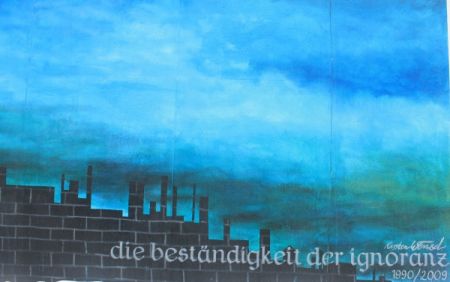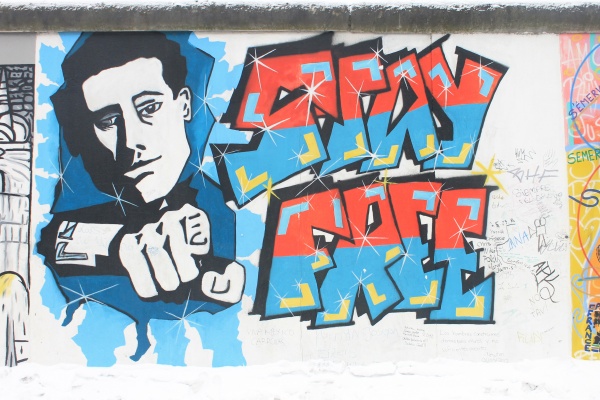The planned removal of a section of the Berlin Wall has commenced to make way for a luxury flat. I stare at a photograph of a crane lifting up a section of the wall, the image increasingly blurred. Outside my window a punter asks his tourists as they slowly move along the river: “Anyone like history? Do you like history?”
They’re tearing down the wall.
It was the Cold War, and Berlin was at the heart of it all: a divided city in a divided country in a divided continent in a divided world. The Berlin Wall was a barrier – concrete walls, border guards, a wide Death Strip – constructed by the German Democratic Republic (East Germany) in 1961. Completely cutting off West Berlin from surrounding East Germany, the wall prevented mass emigration out of the East: there was a shoot-to-kill policy for those who attempted escape.
In 1989, following a broadcast, thousands of East Germans gathered at the checkpoints along the wall demanding to be let through. The gates at the East-West border were opened; the crowd rejoiced, jumping on the wall, chipping away at it, singing Forever Young.
The wall, it seems, was to be taken down twice: once amidst cheers of freedom and unity, now for access to a new flat.

It was the graffiti that struck me first when I visited. Besides the usual annoying declarations of presence, the wall was overwhelmingly filled with odes to freedom, to peace, to love. Liberty has no price. Blind respect for authority is the greatest enemy of truth. Where someone had written F*ck [name of a country], someone else had crossed out the obscenity and written Hug. The words of the prophets are written on the subway walls, a line from Sound of Silence echoes repeatedly in my mind’s ear. I remember the time when part of the outer wall of the century-old Pudu Jail was demolished, and I went there with a camera desperately trying to preserve what was left – if only in digital format – because fresh, black-marker handwriting on the wall read Snap me, I’m not available soon. Thinking of that half-gone wall and the plan to construct a new shopping complex within it (what would you call it, Penjara Mall?), I was incredibly envious of Berlin then, and I wished we knew how to value a wall like Berlin did.
Berlin invited many international artists to cover the longest remaining stretch of wall with murals, more than a hundred of them, and named it the East Side Gallery. Bleak paintings of people in gas masks, the silent anger of a hand being chained in such a way as to maintain a thumbs-up position, a man pointing directly at the observer with the shining command “stay free,” and that beautiful, beautiful poem:
I painted over the wall of shame
So freedom is ashamed no more,
Inferno ruled too many years
Until the people chose the light.
I put my faith in you, Berlin
And give to you my colours bright!
– Fulvio Pinna, Italy
To be sure, they’re not demolishing the whole length of the wall, nor any substantial length for that matter. It’s only 20 metres out of 1.3km. Yet every inch is significant. Every inch removed is a slippery slope. Every inch is a cold demonstration that it’s only been 25 years, and we are already willing to destroy what we were recently so eager to celebrate with vibrant colours and beautiful words.
What’s the problem, one may ask: Berliners protested against the wall for years, why would they protest for it now? As a tour guide at the Sachsenhaussen concentration camp said, it’s because Germany places great importance on its history, even the darkest parts of it. Every young German would have attended a school trip to a concentration camp as a child, their blissful ignorance of believing nothing so atrocious could ever happen brutally shattered at a tender age. So that they learn to cherish and protect what they now enjoy. Lest they forget, for those who forget history are condemned to repeat it.
Granted, the Berlin Wall is not a feat of architectural magnificence or engineering miracle. It’s no Great Wall or pyramid or pantheon. What it represents is not the coercive power of repression that made possible its construction, but the overwhelming desire of freedom that led to its fall. It signalled the end of a black era of global hostility and paralysing fear.

Maybe I’m overreacting. Maybe I attach too much sentiment to objects, like an obsessive hoarder does. The world is still far from Orwellian. It’s not like books will be burnt and history rewritten the moment two percent of the wall gets removed. Progress leaves no room for nostalgia. Pudu Jail can be replaced with a mall; a politician said “it’s not something to be proud of” anyway. Dataran Merdeka can be cordoned off; we are still independent. The Berlin Wall can fall once again; the Cold War has long ended. These are but mere symbols of a past, long gone, irrelevant. What we do to them makes no difference.
Maybe that cheeky Berlin souvenir magnet was right after all: It’s just a wall – get over it. My history teacher once remarked that the only purpose of buiding a historical monument is so that we can forget about the history. You build a statue, you show that the past has been preserved, your job here is done. Indeed we often forget that physical mementos are no substitute for education and awareness, no indication of true appreciation, no equivalent of memory itself. What matters is not the wall, but the mind. If that’s the spirit, I share it wholeheartedly.
But nothing says “I don’t give a damn about history” like taking down the Berlin Wall to make way for a luxury apartment.
In 1987, President Reagan stood before the wall and famously urged the Soviet leader: “Mr Gorbachev, tear down this wall.” Today, 26 years later, I stand in solidarity with the people of Berlin who cry to their Mayor: Mr Wowereit, don’t tear down this wall.


Good piece, loved it. I have some beautiful shots of the graffiti on the East Side Gallery.
Buildings are like symbols which carry meaning to some people but not to others.
On a related note, should you treasure beauty if people were oppressed and enslaved in the process in the process of creating it?
Good piece, loved it. I have some beautiful shots of the graffiti on the East Side Gallery.
Buildings are like symbols which carry meaning to some people but not to others.
On a related note, should you treasure beauty if people were oppressed and enslaved in the process in the process of creating it?
Nice!
There will always be people who feel differently concerning the following statement:
"What it represents is not the coercive power of repression that made possible its construction, but the overwhelming desire of freedom that led to its fall."
They may not value this wall in the same way.
That's why it's going to make more than feelings to save this wall.